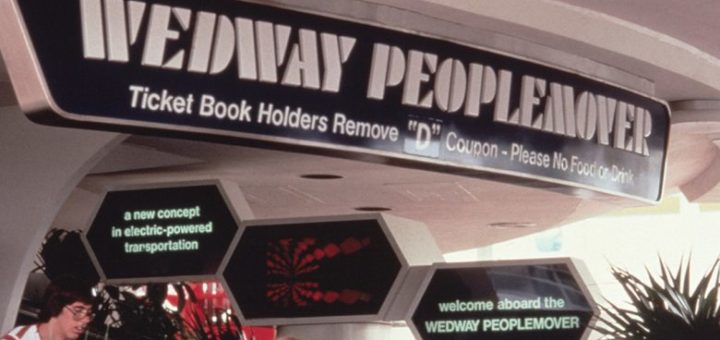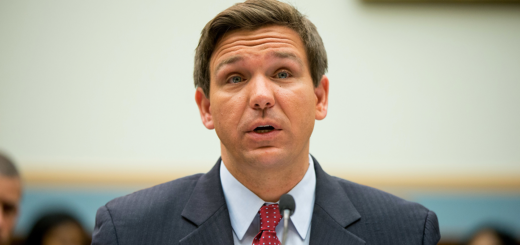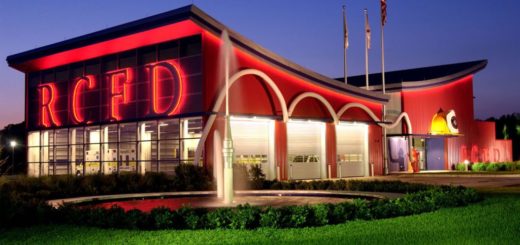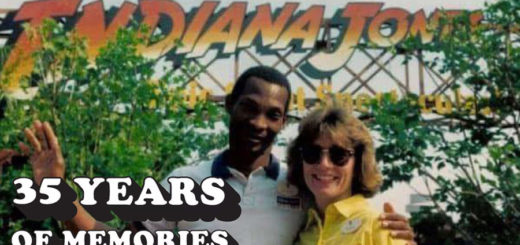How It Got Made: The WEDWay PeopleMover
One of Disney’s greatest failures also represents one of its most beloved attractions.
How did the Tomorrowland Transit Authority PeopleMover get made?
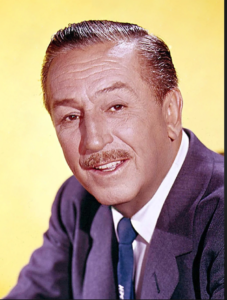

Photo: Disney.wikipedia
That’s a great story, but the better question is, “Why is it not what Walt Disney envisioned?” Let’s discuss.
Again with the World’s Fair
I feel like I discuss the 1964 New York World’s Fair a disproportionate amount. I do this because that event dramatically impacted WED Enterprises.
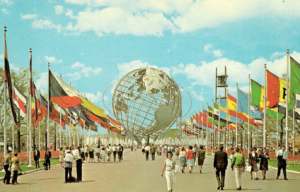

Photo: boweryboyshistory.com
Before the World’s Fair, other businesses respected Disney for its innovations.
Once Disney dominated in 1964 and 1965, other companies perceived them as a threat, albeit one worthy of reverence.
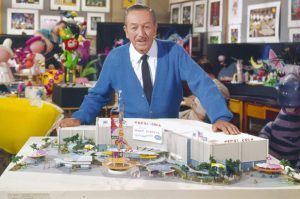

Photo: Disney
Walt Disney and his highly skilled team of Imagineers worked on four pavilions at the World’s Fair.
They were among the five most popular pavilions overall. That’s dominance.
Three of those pavilion attractions turned into Disney theme park attractions. We still have It’s a Small World, Walt Disney’s Carousel of Progress, and Great Moments with Mr. Lincoln.
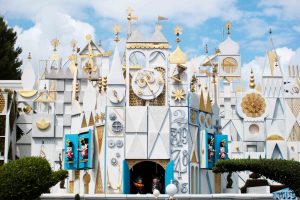

Source: PopSugar
However, the PeopleMover’s origins come from the World’s Fair as well, just from a different ride.
The Ford Motor Company commissioned Disney to create an experience that would make Ford vehicles seem like the best in the world.
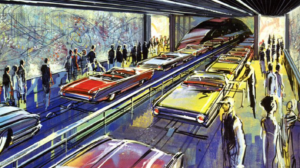

Photo: D23
Disney invented the Ford Magic Skyway, an attraction that walks a fine line between show-stopping themed ride and obvious commercial sponsorship.
Guests would board Ford cars and then travel back in time to the days of the dinosaurs…for some reason. It looked something like this:
Imagineers knew from experience that this premise came with flaws, though. Disneyland’s Autopia had started as a trackless ride.
Guests wrecked into each other so much that Disney eventually added tracks as a guidance system.
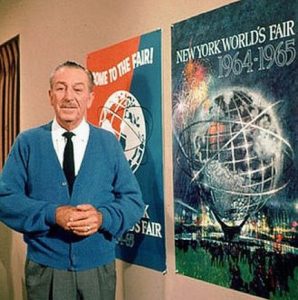

Photo: Disney
The same philosophy applied at the World’s Fair. Disney didn’t want neophyte drivers wrecking Ford vehicles.
So, Disney built something unprecedented at the time, a kind of assembly line without any assembly done. It was the precursor to the Omnimover.


Photo: Disney.fandom.com
Principles of the Omnimover
Theme park designers face unique constraints in their jobs. As a result, throughput represents one of the most vital factors in ride design.
You can build the greatest attraction of all time. But unfortunately, people won’t like it unless they get to ride it.
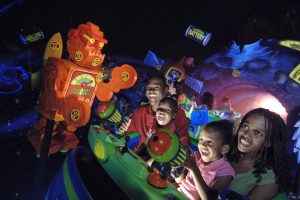

Photo: Disney
That’s why most Disney ride carts use tracks or are capable of hosting a large volume of guests simultaneously.
Disney needs to satisfy as many customers as possible in an hour. Otherwise, guests won’t like the attraction due to its required wait.
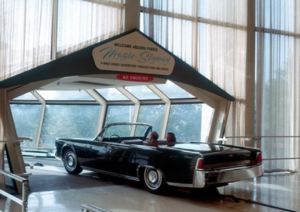

Photo: disney.wikia.com
At the World’s Fair, the Ford Magic Skyway was one of the two most popular attractions. Disney anticipated this and built a system to enhance throughput.
All the Fords would line up in a queue on the track. Then, an unseen chain system at the bottom would pull the vehicles rather than allowing the rider to drive them.
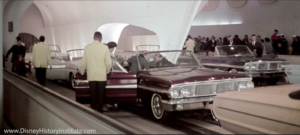

Photo: disneyhostoryinsititute.com
By taking this approach, Disney controlled the speed with which all the Fords drove through the land of the dinosaurs.
If not for this system, people would have inevitably crashed. Some would have taken longer to admire the realistic nature of the dinosaurs.


Photo: D23
Others would have sped through the attraction, caring more about the joy of driving a Ford convertible.
Disney removed control from the user, fundamentally changing the way they evaluated attractions.
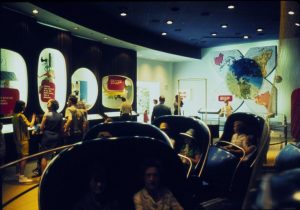

Photo: Disneyland
Soon after the World’s Fair, Disneyland unveiled the first Omnimover attraction, Adventure Thru Space.
Two years later, the more famous Omnimover debuted. Yes, I’m talking about the Doom Buggies on Haunted Mansion.
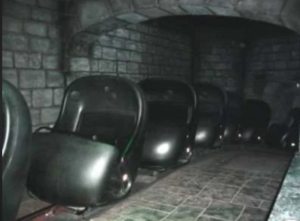

Photo:hanutedmansion.wkia.com
Somehow, that majestic attraction’s ride cart represented a failure for Imagineers, though.
Walt Disney had wanted something more from the premise. He had envisioned a legitimate form of transportation utilizing a connected infrastructure.
The PeopleMover We Got vs. the One Uncle Walt Wanted
On October 27th, 1966, Walt Disney unveiled The EPCOT Film, which announced his ambitions for the Experimental Prototype Community of Tomorrow.
Disney prophesied a futuristic capitalist utopia wherein people would live in the same place where they worked.
Imagineers designed a small-scale model of this place called Progress City. It was an urban planner’s dream of a community.
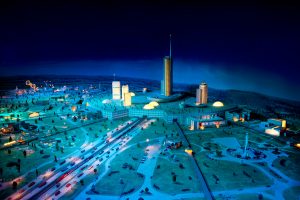

Photo: Disney Parks Blog
Disney had thought of everything, including traffic. As a Southern California resident, the creator was already familiar with the perils of car congestion.
So, Disney’s plan called for the cars to park on the hidden bottom floor of EPCOT.
Transportation would work much differently on the city’s main floor. First, there wouldn’t be a car in sight!
Instead, Disney planned two other forms of transportation as the primary means of moving across the city.


For longer distances, guests would utilize monorails to traverse EPCOT. However, most of the movement would occur on a smaller scale.
When guests only needed to move a few blocks, Disney built a proprietary transportation system called the PeopleMover.
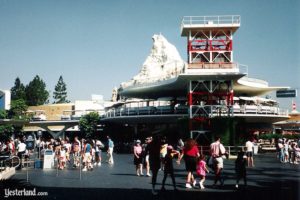

Photo: Yesterland
In fact, Uncle Walt believed that this technology would solve the struggles of urban congestion in many metropolitan areas. So he planned to license the technology.
Yes, in some alternate reality, you might take the PeopleMover to work every day, no matter where you live!
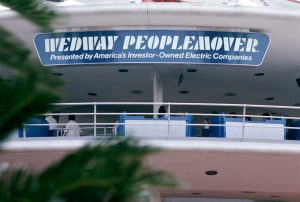

Sadly, Disney only sold the technology to one significant vendor, George Bush Intercontinental Airport in Houston.
That’s the only place in the world that features the WEDWay PeopleMover other than at Disney theme parks.
The airport serves nearly 3 million annual customers with the PeopleMover. So, it’s far from forgotten technology.
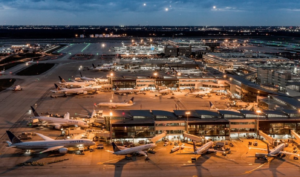

Photo: tsa.gov
However, that’s a far cry from what Walt Disney had expected.
The Modern PeopleMover
So why did he fall short of his goals? Uncle Walt died less than two months after The EPCOT Film.


Credit: Disney
In Walt’s absence, EPCOT as a concept collapsed before eventually reforming in a different shape.
In 1967, Tomorrowland at Disneyland introduced the Goodyear PeopleMover, which provided guests with an overhead view of this themed land.
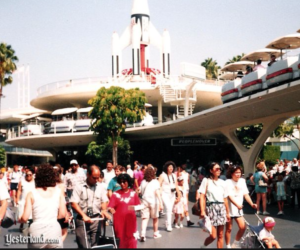

Photo: yesterland.com
Uncle Walt hadn’t intended for the ride to lack utility, though. Instead, he sought a legitimate transportation system. Unfortunately, this version of the PeopleMover didn’t qualify.
Meanwhile, the plans for Progress City never came to fruition. By the time EPCOT opened as a theme park in 1982, Magic Kingdom had added its own PeopleMover.
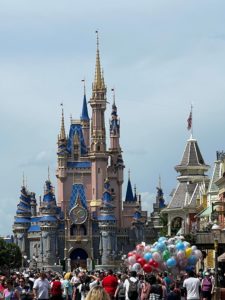

Disney had transitioned the concept from functional transportation service to theme park entertainment by that point.
Imagineers built the WEDWay system in Houston in 1981, but the park plans fell by the wayside.
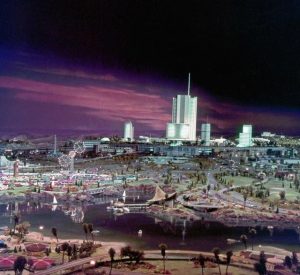

Photo Credit: ImagineeringDisney.com
Now, all we have remaining is the Progress City scale model and the film of what Walt Disney had imagined.
Fittingly, Disney has positioned a part of the Progress City model on display during the early stages of the PeopleMover at Magic Kingdom.
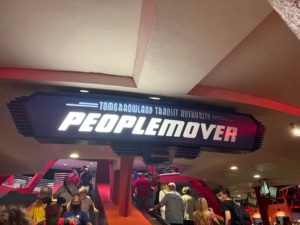

So, you can gaze at what might have been while you ride the attraction.
Somehow, the PeopleMover is both a marvelous theme park achievement and a heartbreaking set of circumstances.
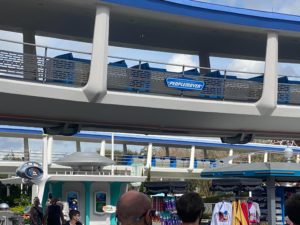

In a better world, Walt Disney would have solved many of the problems of urban sprawl.
Instead, we can experience a guided track transportation system that provides a sweeping view of Tomorrowland at Magic Kingdom.
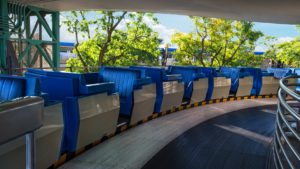

Credit: Disney
At Disneyland, that’s no longer an option. Instead, park officials regrettably chose to reboot the PeopleMover tracks with Rocket Rods, a decision that failed in just two years.
The PeopleMover just cannot catch a break.
Feature Image: D23.com


